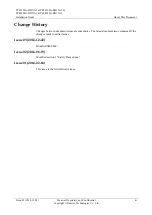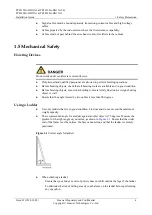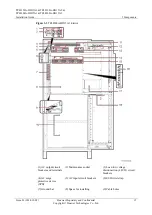
TP48120A-HD15A1 & TP48120A-HD15A2 &
TP48200A-HD15A1 & TP48200A-HD15A2
Installation Guide
1 Safety Precautions
Issue 03 (2014-12-02)
Huawei Proprietary and Confidential
Copyright © Huawei Technologies Co., Ltd.
3
Preventing Battery Short Circuit
Short circuits will generate high transient currents and release a great deal of energy, which
may cause personal injury.
If conditions permit, disconnect the batteries in use before performing any other operations.
Preventing Flammable Gas
Do not use unsealed lead-acid batteries.
Place and secure lead-acid batteries horizontally to prevent device inflammation or
corrosion due to flammable gas emitted from batteries.
Lead-acid batteries in use emit flammable gas. Therefore, store the batteries in a place with
good ventilation, and take measures against fire.
Preventing Battery Leakage
High temperatures may result in battery distortion, damage, and electrolyte overflow.
When the battery temperature is higher than 60°C, check the battery for electrolyte overflow.
If the electrolyte overflows, absorb and counteract the electrolyte immediately. When moving
or handling a battery whose electrolyte leaks, exercise caution because the leaking electrolyte
may hurt human bodies. When you find electrolyte leaks, use sodium bicarbonate (NaHCO
3
)
or sodium carbonate (Na
2
CO
3
) to counteract and absorb the leaking electrolyte.
Preventing Battery Overdischarge
After you connect batteries, ensure that the battery fuse is disconnected or the circuit breaker
is OFF before powering on the power system. This prevents battery overdischarge, which
damages batteries.
1.4 Cable Layout
When cables are used in a high temperature environment, the insulation layer may age
and be damaged. Ensure that a sufficient distance exists between the cables and the DC
busbar, shunt, and fuse.










































